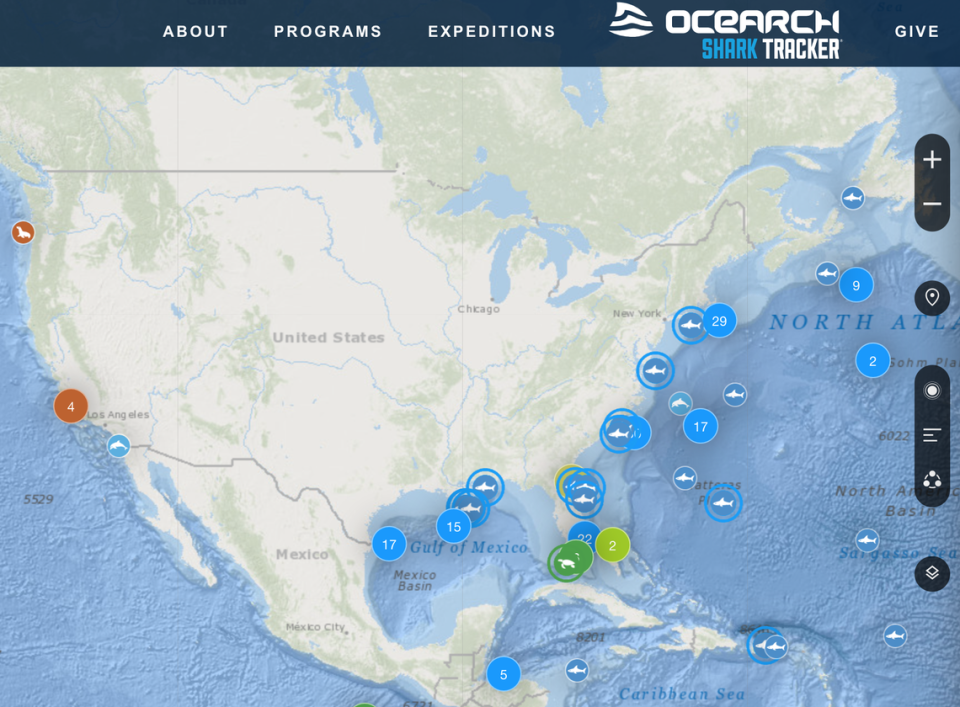Sharks seen swarming the East Coast. Here’s why experts say that’s not unusual
Are sharks unusually gathering along the East Coast?
These creatures were seen swarming the East Coast in a recent viral social media post that caused a stir. However, experts say that’s not unusual.
“Sharks are amassing on the east coast,” the Dec. 1 Twitter post read, sharing a screenshot of the popular OCEARCH shark tracker, which is powered by SeaWorld and captures shark activity in real time.
The photo shows a massive buildup of these marine predators solely along the East Coast.
sharks are amassing on the east coast pic.twitter.com/GDI250biUE
— stuart (@punished_stu) December 1, 2021
“Is this normal? Or could this be a sign of a natural disaster? Or am I overthinking this?” one Twitter user replied to the tweet that has garnered more than 53,000 likes and 3,100 retweets.
“There’s nothing to be concerned about here,” Tobey Curtis, a National Oceanic and Atmospheric Administration fishery management specialist, told McClatchy News over the phone. “Healthy oceans have healthy shark populations.”
“There’s literally millions of sharks in the ocean of dozens of species, and they’ve always been out there doing their thing,” Curtis added. “It’s just that now we have the technology to see where they are in real time,” he said about shark tagging.
In regards to OCEARCH’s tracker, the nonprofit organization “has done most of their recent tagging in the Atlantic, that’s all that shows,” Curtis explained.
As an NOAA expert, Curtis has tagged sharks for several years and even collaborated with OCEARCH in the past, he said.
“It’s the same story on the West Coast. There’s millions of sharks cruising up and down the West Coast as well; they just haven’t been tagged by OCEARCH in recent years,” Curtis added.
The Twitter user’s screenshot came from OCEARCH’s shark tracking app, which can also be accessed online.
At first glance comparing OCEARCH’s website and app, it might seem like there’s more sharks along the East Coast on the app, but you just have to zoom in on the website, OCEARCH spokesperson Paige Finney told McClatchy News in a statement.
“There are the same amount of sharks on both,” Finney said.


When you look at the website, the numbers appearing next to some of the shark symbols means “there are that many additional animals in the location, but you have to zoom in more to see them,” Finney explained.
The vast majority of the sharks that appear on the shark tracker are miles offshore, Curtis said.
“So the suggestion that they’re amassing along the beaches is kind of silly because if you actually zoom in and see where each individual shark is, you know, they occasionally pass kind of near shore,” he noted. “For the most part, they’re miles away from beaches.”
Those along the Atlantic coast are like “snowbirds,” according to Curtis.
“They generally spend their summers in the northern parts of the coast and then in the fall and winter, they migrate south to warmer waters,” he said, adding that many species follow that same pattern.
OCEARCH is currently studying the Northwest Atlantic white shark, according to Finney, and the organization has tagged 83 white sharks off the Atlantic U.S. and Canada over the past nine years.
They tagged 15 white sharks, also known as great whites, this year, she said.
One white shark tagged this year is named “Sarah,” and OCEARCH’s tracker shows that she’s off the coast of North Carolina at the time of writing after being tagged on Sept. 14 in Nova Scotia, Canada, as a juvenile shark.
Sarah is just over 9 feet and weighs an estimated 632 pounds, and the latest “ping” on her tracker was on Dec. 6 at 9:32 a.m.
Off the coast of Nova Scotia, 10 white sharks were sampled, tagged and released by OCEARCH in 2021, Finney said.
OCEARCH’s tracker currently shows a good number of great white sharks along the East Coast, even though they’re actually “one of the least common sharks on the East Coast,” Curtis said.
“They’re just one of the most heavily tagged,” he noted. “There’s like this tag bias that you’re seeing. It’s not that there’s more great white sharks than other species. It’s just that there’s more tagged white sharks than other species.”
Great white sharks generally spend their winters off the coast of Florida, Curtis said.
“They kind of follow the same pattern as a lot of grandparents do every year,” he joked about the particular species. “You know, they spend the cold months down south and then they come back north when it warms up.”
Curtis said that compared with other predators, sharks “somehow are still more mysterious or more maligned.”
“Just like we have bears and wolves on land, it’s a good thing to have good, healthy predator populations,” he added.
OCEARCH doesn’t just track sharks. It also keeps track of sea turtles, dolphins, swordfish and more.
It has tagged 431 animals in total.
Watch a great white shark prey on a seal along Cape Cod coast in Massachusetts
Otter bitten by shark on Oregon coast rescued and brought to aquarium for help
Rare 15-foot great white shark comes within feet of diver off Hawaii coast, video shows
Woman taking morning walk spots manatee stranded on Outer Banks shore, she says

 Yahoo Movies
Yahoo Movies 